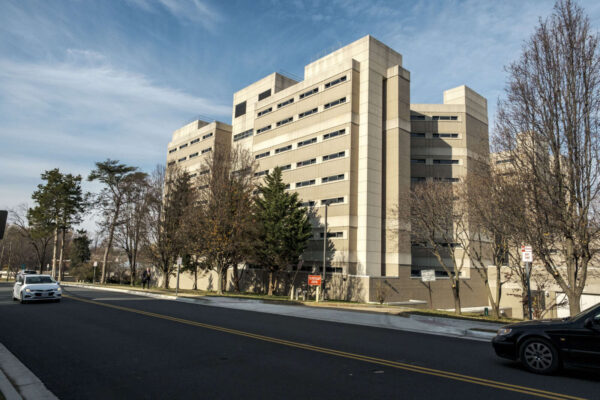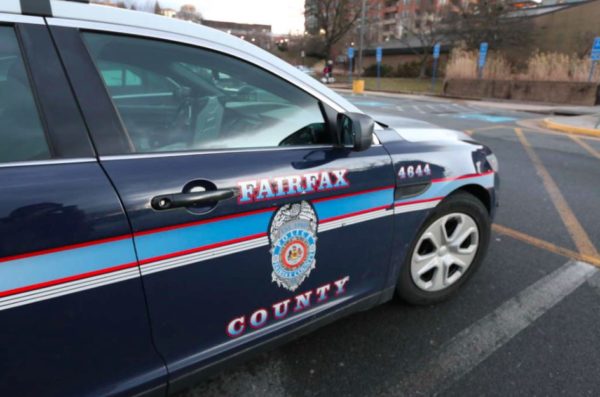Fairfax County’s approach to criminal justice is quite different from when public defender Bryan Kennedy started his job here a decade ago.
In 2010, the county housed 1,207 people in its jail. That population has been nearly halved, down to 667 people in 2020, according to 2020 Census data compiled by The Marshall Project.
Going back further, the county’s inmate population was 3,749 people in 2000. But the changes from 2000-2010 involved the 2001 closure of the Lorton Reformatory, which housed over 2,800 people as of Dec. 31, 1999 and had its inmates moved to other facilities across Virginia and the federal prison system.
More recently, policy and cultural changes have dramatically altered the county’s judicial system, according to Kennedy, who also belongs to the criminal justice reform group Justice Forward Virginia.
“Ten years ago judges sentenced people to jail much more frequently on low level charges (both misdemeanors and felonies), including misdemeanors like possession of marijuana and driving on a suspended license,” Kennedy said in an email. “People were also held pretrial and held on secured bonds (cash bonds) that they could not afford much more frequently.”
After taking office in 2020 as one of three new progressive prosecutors in Northern Virginia, current Commonwealth’s Attorney Steve Descano ended the use of cash bail and stopped prosecuting simple marijuana possession cases prior to the state’s legalization, though future reform efforts could be challenged by Virginia’s incoming Republican administration.
Kennedy told FFXnow that the judicial system is now more receptive to alternatives to incarceration, as judges and prosecutors feel more comfortable not placing people in jail, because those individuals are getting more services outside of jail.
County Adopts Diversion Framework
One possible driving force behind the decline in Fairfax County’s incarcerated population in the last decade is its Diversion First policy, which began in 2016 after Natasha McKenna’s death at the Fairfax County Adult Detention Center in February 2015.
The initiative aims to reduce the incarceration of people with mental health and substance use issues, as well as intellectual and developmental disabilities, by directing those arrested for nonviolent offenses to services instead of jail, which the county says is less costly. Read More
Fairfax County’s work release program has been shuttered since March 2020 due to the pandemic. But when the transitional program restarts, the Fairfax County Sheriff’s Office is unsure how it will be able to manage it.
Faced with an uncharacteristically high vacancy rate of 11.4%, the sheriff’s office says it’s changing how it operates to make basic functions possible. The office is tasked with operating the detention center, providing security for the courthouse and courtrooms, and serving the civil law process.
“Whenever the health department recommends that we can safely restart work release, we need to evaluate if we have sufficient staff to actually restart it,” said Andrea Ceisler, a spokesperson for the sheriff’s office.
To manage, the office has redeployed staff from other areas to the Adult Detention Center and eliminated assignments to specialized units like the fugitive task force and gang unit. Hiring is ongoing, but the number of applications has dipped.
“Even with mandatory overtime, our squads are short-staffed,” Ceisler said. She says the office is also turning down new requests to take part in programs by community groups and schools.
The order to shut down the work release program — which allows some inmates to work and take part in community programs as they transition out of incarceration — came from the Fairfax County Health Department. It’s unclear when it will restart, but the decision will be guided by when community transmission levels are reduced from substantial to moderate or low.
Over the last three years, the number of inmates enrolled in the county’s work-release program has decreased significantly.
In 2017, 112 inmates were enrolled and 44 successfully completed the remainder of their sentence while in the program. In 2019, just 48 inmates were enrolled, though 32 completed the remainder of their sentence.
Over the last 10 years, the need for more staff has also grown — particularly at the detention center.
Cell blocks that can house 20 inmates typically hold 10 inmates, a configuration that dramatically reduces the number of fights and encourages more compliance with rules. An increase in training — including crisis intervention and mental health first aid — also takes off staff from their line of work.
“Should the pandemic end, we will have to evaluate staffing in the Alternative Incarceration Branch where the staff-to-inmate ratio is much smaller for programs such as Work Release, the Community Labor Force and STAR, our addiction treatment and recovery program,” Ceisler said. “For the safety and security of our staff, inmates and the people who live and work in the county, sufficient staffing in the Adult Detention Center must remain a top priority.”
Public safety and law enforcement departments have reported high vacancy rates nationally. Staffing has declined for the past eight years, with 86% of departments across the country reporting a shortage last year.
Major Tamara Gold, the sheriff’s office assistant chief, told the Fairfax County Board of Supervisors last month that the problem is expected to intensify in the coming months.
The office’s staff are paid between 2.5 and 7.5% less than equivalent positions in the Fairfax County Police Department. Many staff has left the office for employment with FCPD, which is grappling with its own staff shortage.
The sheriff’s office did resume its community labor force program earlier this year, where inmates work outdoors in crews of five under the supervision of an armed deputy sheriff. Crews complete landscaping, emergency snow removal, litter pick up, and other tasks.
Photo via Fairfax County Sheriff’s Office/Facebook
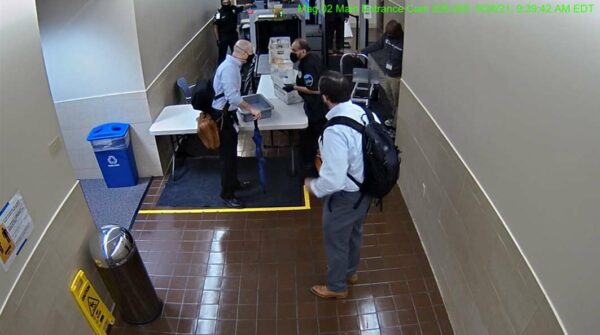
Video of an encounter between Fairfax County’s top prosecutor and security personnel at the county courthouse does not appear to be consistent with some of the allegations leveled in a Fairfax County Sheriff’s Office incident report.
The report claims Fairfax County Commonwealth’s Attorney Steve Descano and a colleague lost their tempers during a courthouse security screening. According to the Sept. 30 report, Descano and Chief Deputy Commonwealth Attorney Kyle Manikas questioned and cursed at security officers when directed to go through a metal detector upon entering the Fairfax County Courthouse at 9:37 a.m. on Sept. 28.
But the two main triggers that the report says prompted Descano and Manikas to display “disrespect” and “unprofessional conduct” toward the security guards are absent from the video, notes a courthouse source who has also seen the footage viewed by FFXnow.
The report states that, after seeing two law enforcement officers in full uniform bypass the checkpoint and being told by the security guards that uniformed law enforcement officers were exempt from the mandatory security screening, Descano responded by saying “That’s bullshit,” “Don’t you know who I am?”, and “I’m the top law enforcement officer in Fairfax County.”
While no audio was recorded, courthouse security camera footage provided by the sheriff’s office does not show any uniformed law enforcement officers coming into the building and passing the security checkpoint.
Around the time Descano arrives, a sheriff’s deputy and a uniformed man wearing a vest emblazoned with the logo for the security company Brink’s walk by the checkpoint, but they are leaving the courthouse, not entering.
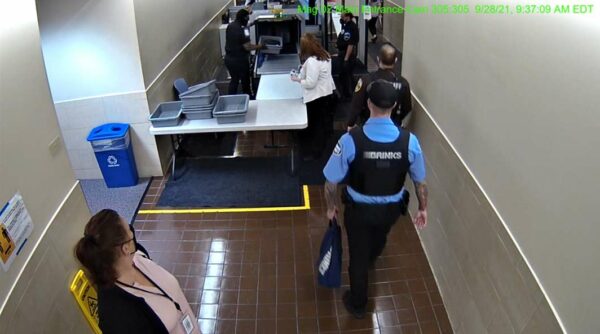
The sheriff’s office report, which is signed by both a deputy and a supervisor, states that the two security guards gave statements and that facility security “provided a video to corroborate the visual part of the incident.”
“We do not have any comments about the report,” the sheriff’s office said when asked about the discrepancies between its incident report and the security camera video.
The report also says Manikas “was visibly upset about being screened and kept saying ‘This is f**king bulls**t.'”
According to the report, Manikas also became upset when told that the x-ray machine detected a knife in his lunch bag and that an additional search of the bag was needed, claiming that there was no knife in the bag.
After a security officer “rotated the screen of the x-ray around to show CDCA Kyle Manikas the image he was looking at,” the report claims the prosecutor stated, “This is f**king bulls**t, I know you are doing your job, but this is bulls**t.” A search of the bag revealed a butter knife.
In the video, however, when one of the security officers gestures that he needs to look through Manikas’s backpack, Manikas unzips the bag and opens what appears to be a lunch box without any visible hesitation. The officer doesn’t show Manikas a screen, and his side of the x-ray machine is inaccessible to visitors, blocked by the tables where people collect their belongings after getting screened.
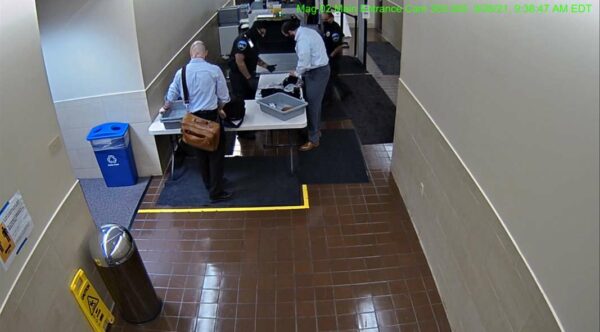
“As the full video reflects, the report paints an inconsistent picture of what actually occurred,” Benjamin Shnider, chief of staff for the Fairfax County Office of the Commonwealth’s Attorney, said in a statement to FFXnow.
Descano and Manikas were not available to comment directly.
The incident report circulated around conservative blogs and media before being reported by the Sun Gazette and FFXnow yesterday (Thursday).
Descano has become a target of conservatives since he was one of three Northern Virginia prosecutors elected in 2019 on criminal justice reform platforms, including pledges to stop prosecuting marijuana possession, end the use of cash-bail and the death penalty, and reduce mass incarceration.
Like his reform-minded counterparts in Arlington and Loudoun, Descano is currently facing a recall effort spearheaded by Virginians for Safe Communities, a group led by Republican operatives and funded by undisclosed donors.
A separate group called Stand Up Virginia launched its own recall campaign against Descano in April.
Both groups argue that his office has failed crime victims by declining to prosecute some misdemeanor cases and offering plea deals that some judges have criticized as inadequate.

An incident report from the Fairfax County Sheriff’s Office alleges that two of the county’s top prosecutors clashed with security guards when asked to undergo a security screening to enter the Fairfax County Courthouse.
The sheriff’s office states in the Sept. 28 incident report that Fairfax County Commonwealth’s Attorney Steve Descano and his chief deputy displayed “disrespect and unprofessionalism” that was “unsuited for an officer of the court.”
When asked to go through metal detectors at the courthouse at around 9:37 a.m. that day, Descano reportedly asked why two uniformed law enforcement officers didn’t go through security. When told by two security officers that law enforcement was exempt, Descano said “That’s bullshit!” and then asked “Don’t you know who I am? I’m the top law enforcement officer in the county,” according to the incident report.
The courthouse routinely requires security screening of all employees and attorneys at the request of the Courthouse Security Committee, which is chaired by Chief Judge Penny Azcarate. Descano reportedly stated that he was exempt from the security screening because of his position.
Descano’s office declined to comment on the incident report. FFXnow has not viewed security footage that the incident report purports corroborates the “visual part of the incident.”
It’s unclear whether Descano and his chief deputy were aware of a new screening policy that appears to have contributed to the verbal altercation.
Under the new security policy, which began on Sept. 1, on randomly selected days, every person entering the courthouse must take part in security screenings.
This requires all individuals to walk through a magnetometer and for all bags, briefcases, purses, parcels, and electronic devices to be screened by an X-ray machine, according to the county’s website, which did not provide information about the new policy until yesterday morning (Wednesday).
A Fairfax County Circuit Court clerk declined to comment on all of FFXnow’s questions, including why the new policy was put in place, why uniformed law enforcement officers are exempt, and how it differs from the court’s previous procedures, including an option that allows attorneys to bypass security screenings.
According to the report, Kyle Manikas, the chief deputy commonwealth’s attorney, took issue with a security search of his lunch bag when a knife was detected in the metal detector screening.
“This is fucking bullshit, I know you are doing your job, but this is bullshit,” Manikas reportedly said, as quoted in the incident report. He was described as “physically upset.”
A butter knife was found in the bag.
The incident report concluded that the security officers experienced “disrespect, curse and abuse, and unprofessional conduct.”
Angela Woolsey contributed to this report. Photo via Google Maps
Less than a third of Fairfax County sheriff’s deputies and less than half of Fairfax County Police Department officers have undergone Crisis Intervention Team training, which seeks to help first responders more safely and effectively help people with mental health issues.
Changing how law enforcement handles situations involving mental health issues is the goal of a program that Fairfax County resumed testing earlier this week, pairing CIT-trained officers with mental health specialists to respond to non-criminal 911 calls.
The pilot program is the county’s first step toward fulfilling a state requirement that it have mental health professionals involved in behavioral health crisis responses by July 2023, but it also stems from the ongoing Diversion First initiative aimed at preventing unnecessary arrests and hospitalizations.
FCPD says 46% of its approximately 1,500 officers are currently CIT-trained.
“It is important to acknowledge the county only adopted the current model of CIT in 2016 and is committed to the continual training of department personnel in crisis intervention training,” police said in a statement.
The Fairfax County Sheriff’s Office says 132 of its 439 deputies have received CIT training.
Neighboring counties report more robust adoption rates.
The Loudoun County Sheriff’s Office tells FFXnow that every deputy serving patrol, corrections, or courthouse duties takes the training within their first two years on the force. Since 2016, Arlington County has required that all new officers take the 40-hour course within six months of completing field training.
Differences in training can contribute to discrepancies in how individual officers treat people with mental health or substance use issues. That inconsistency is one challenge facing Diversion First, Fairfax County Chief Public Defender Dawn Butorac told FFXnow in September.
During a public safety committee meeting on Tuesday (Sept. 28), Board of Supervisors Chairman Jeff McKay said the county “is hoping to get many more officers in” CIT training, calling that a baseline qualification for selecting personnel for the co-responder pilot.
Fairfax County adopted the “Memphis Model” of CIT training in 2016 in response to the Ad Hoc Police Practices Commission that the Board of Supervisors formed in 2015 after facing public criticism and a lawsuit over how the county handled a police officer shooting and killing Springfield resident John Geer in 2013.
In a final report released on Oct. 8, 2015, the commission recommended that the FCPD create specially trained crisis intervention teams, provide base-level training for all officers, require CIT training for certain command positions, including in the patrol division, and offer incentives like flexible shift hours to encourage suitable officers to join a CIT.
According to a progress report on the commission’s 202 recommendations, those proposals have all been implemented, but the FCPD did not respond by publication time when asked for details on the incentives it has for officers to get the CIT training.
The FCPD’s CIT-related administrative records and protocols consist of slideshows used for the training and a general order about emotionally disturbed persons, according to a county administrator.
Other kinds of mental health training for county law enforcement include a Mental Health First Aid Day for the sheriff’s office. In addition, the police department’s general order on the use of force states that officers should take into consideration people’s “medical issues, mental health issues, disabilities, or language and/or cultural differences.”
Meanwhile, the Virginia Department of Criminal Justice Services and Department of Behavioral Health and Developmental Services have issued guidance for CIT programs that in fact discourages agencies from giving the training to all patrol personnel “except as necessary to achieve 24/7 coverage.”
“Experience suggests that a successful CIT program will, at a minimum, have 20-25% of the agency’s patrol division, which will likely result in 24/7 CIT officer coverage,” the state guidance says. “The ultimate goal is to have an adequate number of patrol officers trained in order to ensure that CIT-trained officers are available at all times.”
Per the state guidance:
Just as officers for other specialty areas in law enforcement are not equally suited to every job, so it is with CIT officers. CIT is a training that demands officers have certain skills and experience in order to be effective. For example, because CIT asks officers to take a very different approach in dealing with certain situations, it is beneficial to train officers who are extremely comfortable with their basic policing skills and procedures and have been on the road for a significant period of time. Additionally, CIT training is NOT effective as a means of ‘fixing’ an officer who may not have a well developed set of interpersonal skills.
The Fairfax County Sheriff’s Office has 24/7 CIT coverage on every squad and shift, whether deputies are assigned to the Adult Detention Center, courthouse, or civil enforcement, spokesperson Andi Ceisler said.
She noted that all deputies assigned to the Merrifield Crisis Response Center have CIT training.

While the federal eviction moratorium is no more, local experts say a Virginia law that took effect on Aug. 10 still provides notable protections for both renters and landlords in Fairfax County.
The Supreme Court ruled on Aug. 26 that the hold on evictions imposed by the Centers for Disease Control and Prevention was unconstitutional, eliminating a nationwide policy intended to keep people housed during the COVID-19 pandemic.
“[The eviction moratorium] certainly is one protection that’s removed for the tenant,” said Dipti Pidikiti-Smith of Legal Services of Northern Virginia, a local nonprofit that works with Fairfax County to provide pro-bono legal assistance. “But it wasn’t the main protection. There’s a really good state protection in place.”
In place through June 30, 2022, H.B. 7001 prohibits landlords from evicting tenants who have experienced financial challenges due to the pandemic unless they notify renters about the Virginia Rent Relief Program and apply for assistance on their behalf if the tenant doesn’t apply themselves within 14 days.
Pidikiti-Smith says the bill is a very strong protection that helps both tenants and landlords.
“The state provides more protection initially in preventing filing of these evictions because landlords have to apply for rent assistance,” Pidikiti-Smith said. “Once that’s done, the money is there. The landlords get their payment and tenants have relief… and there’s no need to file a case.”
Tenants can apply for up to 15 months of assistance, which could mean anywhere from a few hundred to tens of thousands of dollars, depending on their need and eligibility.
Pidikiti-Smith says she knows one tenant who received $35,000 in relief, though the average is about $5,000 to $6,000. Most tenants who apply do qualify for at least partial assistance.
While the moratorium’s end affected cases already in court, it has had less of an impact statewide on potential evictions.
“We’ve been telling tenants it’s okay that the [eviction moratorium] isn’t in place right now,” Pidikiti-Smith said.
County officials expressed relief last month when the CDC extended its eviction moratorium into October, but they also said the county had ample funds to support those in need.
Earlier this summer, the county set up a new emergency rental assistance program using federal relief funds that has provided more than $12 million in both housing and utilities assistance to about 1,550 households so far, according to data provided to FFXnow.
Before the program was implemented, the county provided more than $28 million in housing, food, and utility assistance from other sources.
Fairfax County Board of Supervisors Chairman Jeff McKay said by email that the Supreme Court’s ruling on the federal eviction moratorium was “not ideal.” Read More


